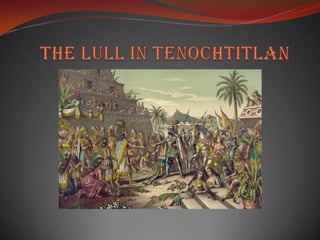
The Lull during the First Stay in Tenochtitlan
- 1. The Lull in Tenochtitlan
- 2. Introduction The Spaniards under command of Hernan Cortés first arrived in Tenochtitlan, the capital of Mexico, on November 8, 1519. Upon entering Tenochtitlan the Spaniards soon decided it was in their best interest to take Montezuma captive, holding him as collateral for their safety. Their stay amounts to a little over six months, or until May of the next year. Between the capturing of Montezuma and when Cortés takes leave of the Capital to address Panfilo Narvaez’s arrival in Vera Cruz, Cortés and the Spaniards gathered gold, information, and they made attempts to convert the Aztecs.
- 3. Investigation Cortés, Díaz, and the Aztecs all agreed that it was a time of investigation for the Spaniards. Cortés and Díaz both understand that the time was not to be wasted as any information revealed then could make their lives much easier and this proved to be true as we will see later on. Even the Aztecs took note of the Spaniards keen interest as they relate, “The Spaniards examined everything they saw. They dismounted from their horses, and mounted them again, and dismounted again, so as not to miss anything of interest.” Shown here is Tenochtitlan centered on the Lake of Mexico and surrounded by its vassal states.
- 4. New Knowledge Obtained Cortés, who gave his account in the most detail, tells of the knowledge he acquired while he quartered in Tenochtitlan. The most important mystery is addressed first as Cortés orders guides sent with his men to find out where the Aztecs mined gold. He quickly learned that they obtained their gold from rivers near the provinces of Cucula, Tamazulapa, Malinaltebeque, Tenis, and Tuchitebeque. Aside from the whereabouts of gold, Cortés learns: roughly the extent of Montezuma’s rule which is over 200 leagues to the north and south of the city, the Aztec’s order of government, the layout of Tenochtitlan, the enemies of Montezuma, the particular food and goods traded in the marketplace in Tenochtitlan, the temples and the Aztec’s sacrificial practices, the source of their drinking water, and Montezuma’s habits which are all observed closely. Cortés even began to build ships, farms, and a settlement near a port close to the lake of Mexico.
- 5. Tribute and Gold Taken During the mapping of the land and gathering of valuable information, tribute was taken indifferently across the Aztec empire. The indigenous recall, They(Spaniards) questioned him closely and then demanded gold. Montecuhzoma guided them to it. They(Spaniards) surrounded him and crowded close with their weapons…the Spaniards searched through the whole treasure house, questioning and quarreling, and seized every object they thought was beautiful…They seized these treasures as if they were their own, as if this plunder were merely a stroke of good luck.” Even Díaz and Cortés admit to the taking of Montezuma’s treasure, but only after his consent as a gift. Díaz description here could perhaps be one of the foremost reasons to writing his account of the conquest of Mexico. He disclosed how the gold was divided among the Spaniards. The royal fifth was first taken, then Cortés’ fifth which the soldiers promised him. Then gold was taken to cover the expenses of the burned ships in which they had come to the mainland. Next, gold was taken to cover the expenses of the horses that had been killed. Finally, the Captains were paid and there was so little gold left for the foot soldiers that many didn’t even want it.
- 6. Attempts at Conversion The last major occurrence during the Spanish stay in Tenochtitlan was the attempts to convert Montezuma and his priests. Díaz’s account tells us that Cortés pressured Montezuma into setting up altars and the image of the Holy Lady in their palace. On the other hand, Cortés claims that he cast down their idols from their temples, putting the cross in their place and altogether stopping the sacrifices committed by the Aztecs. Díazrecants that they could not stop their sacrifices from the fear of mass uprisings. A picture taken from the Codex Mendoza,created by native scribes for the Spanish in 1541-1542, showing a ritual Aztec sacrifice.
- 7. Conclusion Due to the Spaniards demand for tribute and the insulting of their idols, we can guess there was little doubt that tensions between the people of Tenochtitlan and the Spaniards mounted. Díaz admitted to becoming accustomed to sleeping in his armor so as to be ready for battle at any given moment. One small rebellion even took place during their stay. The lord of Texcoco, Cacamatzin, tried to build support against the Spaniards but was quickly taken captive by Montezuma and imprisoned by Cortés. These events begin to signal the growing animosity between the indigenous and the Spaniards. Even though Cortés learns many tricks and uncovers mysteries of the Aztecs during his stay, it comes at a large price as you shall see after the arrival of Panfilo Narvaez and his Spanish army.
- 8. End Notes Cortés, Letters from Mexico. Yale University Press. 1986. 113. Díaz, The Discovery and Conquest of Mexico. De Capo Press. 1996. 196. Cortés, Letters from Mexico. Yale University Press. 1986. 113. Leon-Portilla, The Broken Spears. Beacon Press. 65. Cortés, Letters from Mexico. Yale University Press. 1986. 96. Cortés, Letters from Mexico. Yale University Press. 1986. 92-93. Cortés, Letters from Mexico. Yale University Press. 1986. 94-112. Diaz, The Discovery and Conquest of Mexico. De Capo Press. 1996. 238, 246- 247. Leon-Portilla, The Broken Spears. Beacon Press. 66-68. Díaz, The Discovery and Conquest of Mexico. De Capo Press. 1996. 249-250. Díaz, The Discovery and Conquest of Mexico. De Capo Press. 1996. 251-252. Díaz, The Discovery and Conquest of Mexico. De Capo Press. 1996. 254. Cortés, Letters from Mexico. Yale University Press. 1986. 98. Díaz, The Discovery and Conquest of Mexico. De Capo Press. 1996. 244.